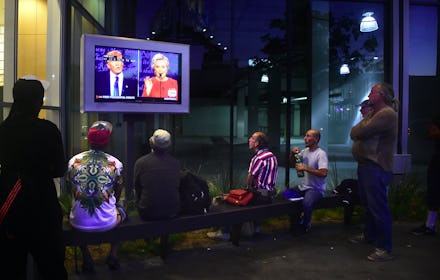Donald Trump's worst enemy at the debate wasn't Hillary Clinton — it was the split screen

Using a split-screen during a presidential debate is nothing new — just ask former Vice President Al Gore.
During a debate against George W. Bush in the 2000 election, Gore apparently didn't realize the power of the split screen when the cameras showed him reacting to his opponent's answers with exasperation and frustration.
Several news outlets aired the entire debate between Donald Trump and Hillary Clinton with a split screen, and at times it got the best of Trump.
Viewers were able to see both candidate's reactions to each other during the 90-minute debate. Trump was often agitated and repeatedly interrupted Clinton.
"Donald Trump rose to every little bit of bait, and fell into every trap, that Hillary Clinton set for him. And she, in stark contrast to him, made (almost) every point she could have hoped to make, and carried herself in full awareness that she was on high-def split-screen every second. He was constantly mugging, grimacing, rolling his eyes—and sniffing. She looked alternately attentive and amused," wrote James Fallows in the Atlantic.
"If you were applying the famous 'How does this look with the sound turned off?' test, you would see a red-faced and angry man, and a generally calm-looking woman," he added.
"He became combative and rattled, letting his opponent lead him down rhetorical detours (at one point he revived an old feud with Rosie O'Donnell) knowing that he would follow his engrained ABCs: always be counterpunching," wrote New York Times TV critic James Poniewozik.
Clinton appeared fairly calm and collected, often letting Trump speak over her in what appeared to be a calculated move to allow her opponent to undo himself.
CNN's Brian Stelter reported the candidates knew that they would be on a split screen.